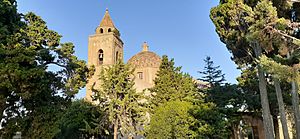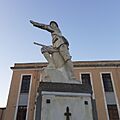Villanovafranca facts for kids
Quick facts for kids
Villanovafranca
Biddanoa Franca
|
|
|---|---|
| Comune di Villanovafranca | |

Church of San Lorenzo
|
|
| Country | Italy |
| Region | Sardinia |
| Province | South Sardinia |
| Area | |
| • Total | 27.59 km2 (10.65 sq mi) |
| Elevation | 292 m (958 ft) |
| Population
(30 November 2015)
|
|
| • Total | 1,373 |
| • Density | 49.764/km2 (128.89/sq mi) |
| Demonym(s) | Villanovesi |
| Time zone | UTC+1 (CET) |
| • Summer (DST) | UTC+2 (CEST) |
| Postal code |
09020
|
| Dialing code | 070 |
| Patron saint | San Lorenzo |
| Saint day | August 10th |
Villanovafranca (also called Biddanoa Franca in the Sardinian language) is a small town in the Italian region of Sardinia. It's located about 50 kilometers (31 miles) north of Cagliari. The town is also about 13 kilometers (8 miles) northeast of Sanluri.
Villanovafranca shares its borders with several other towns. These include Barumini, Escolca, Gesico, Guasila, Las Plassas, and Villamar. Two important places to visit are the nuraghe Su Mulinu and its museum. The beautiful church of San Lorenzo is also a big attraction.
Contents
A Look Back: History of Villanovafranca
The name Villanovafranca likely means "new free town." This suggests it might have been a place without taxes. However, old papers don't clearly say if the town was built this way. It might have started as a farming village and later got tax-free benefits.
Ancient Roots
Even before its current name, people lived here. We know this from ancient nuraghe settlements. These are old stone towers built by the Nuragic people. A famous scholar named Goffredo Casalis wrote about Villanovafranca. He said it seemed like the newest town in the Marmilla area. He also noted it was on the edge of the old Arborense kingdom.
Founding and Feudal Times
Another scholar, Pasquale Tola, was the first to give a founding date for the town. He said Villanovafranca was founded in 1219. The town we see today was built around the 15th century. This was during the Aragonese period. In 1541, it became part of the Barony of Las Plassas. This land belonged to the Zapata family.
Becoming a Modern Town
The town was freed from this feudal system in 1839. This meant it no longer belonged to a powerful family. From then on, Villanovafranca became a municipality. A mayor and a town council started to run it.
Places to Explore
Villanovafranca has many interesting places to visit. These include ancient sites and beautiful churches.
Ancient Sites: Nuraghe Towers
The area is home to several ancient Nuraghe sites. These are stone structures from a very old civilization.
- Nuraghe Su Mulinu
- Nuraghe Tuppedili
- Nuraghe Trattasi
- Nuraghe Paberi
- Nuraghe Barraka is Dragonis
- Nuraghe Cuccuru S'Arriu
- Nuraghe Barbaraxinu
- Nuraghe Perdu Atzeni
Religious Buildings
- Parish Church of San Lorenzo: This is a very important church in Villanovafranca. Inside, you can see a marble pulpit from the 1800s. There are also many wooden statues. One special statue is of the patron saint, San Lorenzo. It has a beautiful silver grill. The church also has an old organ from the 1700s. Its unique bell tower and dome can be seen from far away.
- Church of San Sebastiano
- Church of San Francesco da Paola
- Church of the Madonna della Salute: This church features stone sculptures. These were made by local artists Romano Porcu and Gesuino Murgia.
Other Interesting Buildings
- Soldier's house
- Manor house Santa Cruz
Culture and Museums
Su Mulinu Archaeological Museum
The Su Mulinu Archaeological Museum opened in 2002. It used to be a place where wheat was stored. The museum displays many items found at the Nuraghe Su Mulinu site. These objects show history from the Prehistoric Age to the Early Middle Ages.
Local Economy
The economy of Villanovafranca is mainly based on farming.
Farming and Local Products
Growing durum wheat is very important here. Farmers also grow olives, vines, and almonds. A special local product is saffron. This saffron has a special European Union mark (DOP). This mark means it's a protected product from this area.
Livestock Farming
There are also many farms that raise animals. These farms have pigs, sheep, and cattle. Some of these farms are quite large. They provide many jobs for the people living in Villanovafranca.
Images for kids
See also
 In Spanish: Villanovafranca para niños
In Spanish: Villanovafranca para niños


